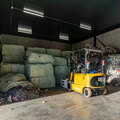As we grapple with the global plastic crisis, innovative technologies are emerging to challenge the traditional linear model of plastic use, disposal, and environmental impact. One such revolutionary solution is plastic pyrolysis, a process that holds the promise of transforming our approach to plastic waste management. In this in-depth exploration, we will delve into the intricacies of plastic pyrolysis machine, its environmental implications, economic viability, and its potential to redefine our relationship with plastic waste.

Section 1: Understanding Plastic Pyrolysis
1.1 The Basics of Pyrolysis Technology
At its core, plastic pyrolysis is a chemical process that involves the thermal decomposition of plastic waste in the absence of oxygen. This results in the breakdown of complex hydrocarbons into simpler compounds, yielding valuable resources like fuel oil, carbon black, and syngas. This departure from traditional disposal methods presents a paradigm shift in our approach to plastic waste.
1.2 The Environmental Imperative
Plastic pollution has reached crisis levels globally, with landfills overflowing and oceans bearing the brunt of our plastic addiction. Plastic pyrolysis offers a ray of hope by addressing the environmental challenges associated with conventional disposal methods, reducing the burden on landfills, and mitigating the impact on ecosystems.
Section 2: Economic Viability of Plastic Pyrolysis
2.1 Turning Waste into Wealth
One of the most compelling aspects of plastic pyrolysis is its potential to turn waste into a valuable resource. The by-products obtained through pyrolysis, such as fuel oil and carbon black, can be used in various industrial applications, providing economic incentives for businesses and waste management facilities.
2.2 Job Creation and Industry Growth
The establishment and operation of plastic pyrolysis plants contribute to job creation, ranging from skilled technicians to plant operators. Additionally, as the industry grows, it stimulates economic activity and fosters innovation in recycling and resource recovery.
Section 3: Environmental Impact
3.1 Reducing Greenhouse Gas Emissions
Traditional plastic disposal methods, such as incineration, contribute significantly to greenhouse gas emissions. Plastic pyrolysis, on the other hand, offers a more environmentally friendly alternative by producing energy without direct combustion, thereby reducing carbon footprints.
3.2 Mitigating Ocean Pollution
The menace of plastic pollution in oceans is a pressing concern. Plastic pyrolysis provides a way to intercept plastic waste before it reaches water bodies, offering a proactive approach to mitigating the devastating effects on marine ecosystems.
3.3 Soil Remediation and Conservation
Landfill sites often result in soil contamination, posing risks to both flora and fauna. By diverting plastic waste from landfills through pyrolysis, we not only prevent soil degradation but also contribute to the conservation of natural habitats.
Section 4: Challenges and Opportunities
4.1 Technological Challenges
While plastic pyrolysis holds immense promise, it is not without its challenges. Technological advancements are required to improve efficiency, scalability, and the quality of end products. Research and development in this field are critical for overcoming these hurdles.
4.2 Regulatory Landscape
The success of plastic pyrolysis hinges on supportive regulatory frameworks. Governments and environmental agencies must collaborate to create policies that encourage the adoption of pyrolysis technology while ensuring adherence to environmental standards.
4.3 Public Awareness and Acceptance
Public perception plays a pivotal role in the success of any waste management strategy. Educating the public about the benefits of plastic pyrolysis and dispelling misconceptions is crucial for widespread acceptance and adoption.

Section 5: The Road Ahead
5.1 Research and Innovation
Investment in research and innovation is paramount for the continued evolution of plastic pyrolysis technology. This includes exploring novel catalysts, optimizing process parameters, and developing new methods to handle diverse types of plastic waste.
5.2 Collaborative Efforts
Addressing the plastic crisis requires collaborative efforts from governments, industries, and the public. Partnerships between stakeholders can facilitate the development and implementation of effective plastic waste management strategies, with plastic pyrolysis at the forefront.
Conclusion
In conclusion, the promise of plastic pyrolysis extends beyond landfills, offering a transformative solution to the plastic pollution crisis. By embracing this innovative technology, we not only address environmental concerns but also unlock economic opportunities and pave the way for a more sustainable and circular approach to plastic use. As we navigate the complexities of waste management, plastic pyrolysis stands as a beacon of hope, challenging us to rethink our relationship with plastic and envision a future where waste is no longer a burden but a valuable resource.





